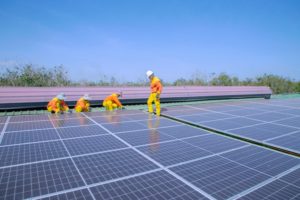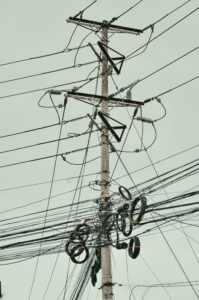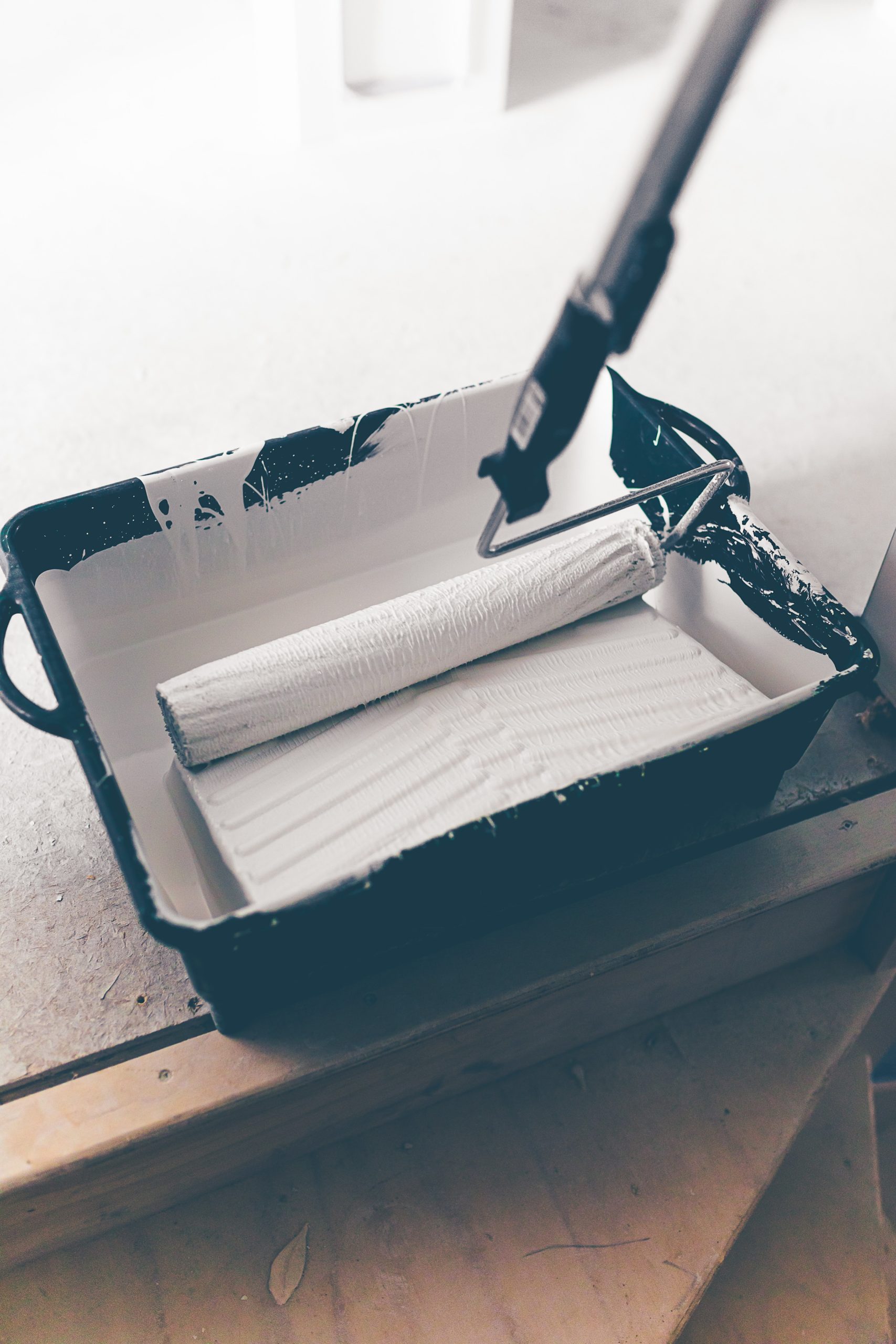What is the solution?
White roofs are a low-cost, low-carbon, low-energy solution to cool down indoor temperature. This traditional practice has been proven around the world for centuries. In countries with a warm climate, such as Southern Europe or North Africa, it is extremely common to see traditionally white buildings.
On a sunny day, a roof that strongly reflects sunlight can stay much cooler than a roof that strongly absorbs sunlight. This is called the albedo effect. Because of their color, white roofs better reflect sunlight and minimize solar absorption by the building than darker ones. (1) The temperature inside the building decreases, thus limiting the use of air conditioning and the associated greenhouse gases emissions (GHGs). Some insulating and reflective paints, membranes or roof tiles further enhance this effect (“Cool Roof” – see list of techniques and companies below).
Why is it important?
High temperature in a building cause discomfort, health risks, and reduce the productivity of people working inside. With climate change, heat waves increase in frequency and intensity, multiplying those risks. Managing thermal comfort becomes unavoidable. (2) Also, hundreds of thousands of dark (and thus warm) roof and roads in large cities increase urban temperatures: it is the urban heat island effect.
To face temperature increase, the common reaction is to turn on air conditioning when available. Air conditioning can account for 20% of energy consumption in large office buildings and a simple 1°C cooling can represent 10% energy savings. (3) In addition to being a significant source of greenhouse gas emissions – as energy consumption is heavily relying on fossil fuels – it also consumes the majority of worldwide Hydrofluorocarbons (HFCs), which are potent greenhouse gases.
Cooling the indoor temperature without air conditioning thus helps to mitigate and adapt to climate change. Moreover, being low-cost and easy-to-implement, white roofs allow for widespread implementation including in low-income countries. This is a key solution for rapid dissemination in the aid sector, where time is of the essence.

Key actions
-
#1 Assess the roof's potential to become cooler
Assess the condition of the roof. An old, damaged or leaking roof may need to be repaired or insulated first before being painted. Its composition will help determine the type of product to apply. The accessibility of the roof is also an important issue, as it will affect the equipment and safety measures needed. Remember that in some cultures or regions, roofs are also used for other purposes (sheeting, storage, meetings, security surveillance). Also, the presence of trees and possible leaf fall can affect the durability of your cool roof.
-
#2 Set the budget
Before investing in white paint – a simple or extra efficient one (such as “Cool Roof”), calculate the estimated cost of the purchase and the estimated energy gain.
-
#3 Assess products
Depending on the local environment, some paints will be better than others. Some are also more eco-friendly than others. Look for the most adequate, local and environmentally friendly product possible. In the case of a “Cool Roof” special paint or membrane, the material is not just a white paint, it is a specific product with special characteristics. Depending on the type of roof, different types of products exist.
-
#4 Assess suppliers
Look for local and environmental friendly suppliers, along with global partnerships.
-
#5 Install, maintain and keep the roof clean
Find or train a team to apply the material, maintain and clean the roof once turned into a white or “Cool Roof”. A white roof covered with dust or leaves will perform less well. Seek advice from the supplier, take a long-term view and train appropriate persons.
-
#6 Implement additional measures
Even the coolest roof will probably not reduce the temperature enough for one’s comfort. Keep in mind that the electricity bill will be considerably lower if air conditioning is reduced. Choose energy-efficient appliances and keep air conditioning installations well maintained. Consider using fans, which use 100 times less electricity than air conditioners and do not contain refrigerant gases. Make sure building are well insulated and ventilated. Take steps to avoid leakage of HFCs in the manufacture, maintenance and disposal of air conditioning equipment.
To consider
-
Potential co-benefits
- Heat-related mortality reduction (8)
- Indoor comfort and occupant health improvement
- Energy bills reduction
- Reduction of peak electricity demand and electrical grid strain, which eventually helps prevent power outage
- Air conditioners life extension (due to lower usage) and reduction of purchases of new equipment
- Roof life extension (less overheating of materials)
- Job creation
- Lower local outside air temperatures, thereby lessening the urban heat island effect (9)
-
Success conditions
- Products adapted to the local climate, neighbourhood and type of roof, and properly applied
- A clean roof
-
Prerequisites & specificities
- Although white and “Cool Roof” paints are particularly suited to hot and sunny regions, they are also useful in temperate and continental climates
- Use appropriate product and asses it (“Cool Roof” coating is not just white paint (10))
- After applying a “Cool Roof” coating, the roof will no longer be usable for other purposes
- Refer to the Cool Roof Rating Counsel (CRRC) that provides a list of trustful product qualifying as “Cool Roof” in their CRRC Rated Products Directory (11)
- After three years of exposure, some “Cool Roof” membranes lose between 25% to 50% of reflectiveness. This makes it necessary to reapply new reflective coats and use high-quality materials
-
Potential risks
- In cold climates or during cold winter months, white or “Cool Roofs” can increase the need for heating energy. This disadvantage is generally smaller than the gain in summer (12)
- A bright white roof on a low-rise building may glare sharply and disturb occupants of taller neighbouring buildings
Point of attention
-
Green roof, solar roof: a better alternative to white roofs?
Depending on context, budget and long-term investment and maintenance capacity, green or solar roofs may be a better alternative to white roofs. Solar roofs are more expensive and complex to implement and maintain, but they produce renewable energy by absorbing rather than reflecting sunlight, which they convert into electricity. Similarly, green roofs are more expensive and complex to maintain, but provide insulation against cold and heat, both in summer and winter, and contribute to the reduction of the urban heat island effect. (13) (14)
Tools and good practices
To go further
-
Study of the impact of cool roofs, natural ventilation and ground thermal inertia on the energy performance of commercial buildings
This study shows that the simultaneous use of cool roof, natural ventilation combined with strong thermal inertia of a building can be a solution of passive cooling satisfactory in summer (in French)
Read here
List of reflective roofs techniques and companies
-
List of reflective roofs techniques and companies
- Cool Roof Rating Council directory
- Cool roof paint
- Heat welded reflective sheet
- Heat reflective tiles
- Planted roofs also prevent heat transfer inside buildings
Energy and buildings

Energy consumption of buildings

Painting the roofs of buildings white: a century-old practice
Sources
(1) Heat Island Group, “Cool Roofs”. Read here.
(2) International Energy Agency and UN Environment Programme, Cooling Emissions and Policy Synthesis Report: Benefits of cooling efficiency and the Kigali Amendment, 2022. Read here.
(3) ADEME, “Écoresponsable au bureau : Actions efficaces et bonnes résolutions”, 2020. In French. Read here.
(4) BBC News, “How much can painting a roof white reduce its temperature?”, 2019. Read here.
(5) Heat Island Group, “Cool Roofs”. Read here.
(6) International Energy Agency, “Press Release: Energy saving actions by EU citizens could save enough oil to fill 120 super tankers and enough natural gas to heat 20 million homes”, 2022. Read here.
(7) Berkeley Lab, “Global Model Confirms: Cool Roofs Can Offset Carbon Dioxide Emissions and Mitigate Global Warming”, 2010. Read here.
(8) Helen L.Macinty, Clare Heaviside, Xiaoming Cai, Revati Phalkeyade, “Comparing temperature-related mortality impacts of cool roofs in winter and summer in a highly urbanized European region for present and future climate”, Environment International 154. Read here.
(9) Keith Oleson (National Center for Atmospheric Research, Boulder) found that large-scale cool roofs would cut the UHI effect by 1/3. He also warns that heat island mitigation should be evaluated on a case-by-case. Oleson, Keith, G. B. Bonan, and J. Feddema, “Effects of white roofs on urban temperature in a global climate model”, Geophys. Res. Lett., 37, 2010. Read here.
(10) Surecoat Systems, “SureCoat Roofing Case Study: White Roof Paint vs. White Roof Coating”. Read here.
(11) CRRC Rated Products Directory. Explore here.
(12) Heat Island Group, “Cool Roofs”. Read here.
(13) Noah Garrison, Huffpost, “White Roofs vs. Green Roofs: Recent Reports Declaring a Victor Overlook That Both Are Wins for the Environment”. Read here.
(14) Project Drawdown, “Green and Cool Roofs”. Read here.
(15) Cool Roof France, “Réalisation – Péniche Hôpital Paris (75)”. In French. Read here.
(16) Challenge Works, “Million Cool Roofs Challenge”. Read here.
(17) Cool Roof France, “Réalisation – Wakhinane Nimzatt – Dakar (Sénégal)”. In French. Read here.
(18) ADEME and Cool Roof France, “Fraîcheur sur la ville : Démonstration et promotion du Coolroofing au Sénégal”. In French. Read here.
(19) Cool Coalition, “Cool Roofs: Community-Led Initiatives in Four Indian Cities,” 2021. Read here.
(20) Cool Roof France, “Réalisation – Leclerc – Anglet (64)”. In French. Read here.
Cover photo © Callum Hill/Unsplash.
